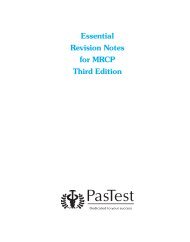OSCEs for Medical Students, Volume 3 Second Edition
OSCEs for Medical Students, Volume 3 Second Edition
OSCEs for Medical Students, Volume 3 Second Edition
You also want an ePaper? Increase the reach of your titles
YUMPU automatically turns print PDFs into web optimized ePapers that Google loves.
136 <strong>OSCEs</strong> <strong>for</strong> <strong>Medical</strong> <strong>Students</strong>, <strong>Volume</strong> 3STATION 1.10AnswersExamination of gaitAssessment Good Adequate Poor/not done1 Appropriate introduction (full name androle)2 Explains purpose of examination3 Candidate washes their hands using thealcohol handwash provided (no marks ifcandidate only expresses the need towash if handwash is provided)4 Observation of child with comment onfacies, signs of UMN posture5 Observation of gait walking away andtowards6 Examines balance7 Asks and observes run8 Categorises gait correctly9 Examines leg muscle tone, reflexes10 Offers to measure leg lengths11 Does examination in professional mannerCommentGait is a hard station, but <strong>for</strong>tunately in paediatrics it will almost always be a childwith cerebral palsy, and just occasionally with a muscular or LMN weakness. As withmost other examination stations, a systematic approach is needed. Ask the child towalk about 10 metres away and then return. Things to look <strong>for</strong> are scissoring gait(legs adducted), toe-walking and the arms in an UMN posture, all suggestinghypertonia, often found with cerebral palsy. Occasionally there may be a cerebellar orco-ordination problem that can be examined with heel toe-walking or balance witheyes closed.Confirm your findings with a brief neurologic examination on the couch. Look <strong>for</strong>scars of tendon releases, <strong>for</strong> increased tone and reflexes.
















